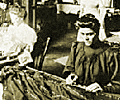
 |

 |





|
Preparation:
Lesson Plan:
Possible Extensions:
Evaluation:
|
|
Suggested Activity: Discussion Question
Emily
Murphy
Imagine you lived in a country
where half of the adult population was not legally considered "persons"
and, as such, were not able to vote. In point form quickly write down your
thoughts about this situation.
Suggested Assignment In groups no larger than four people, explore the Herstory site and discover the different types of information it contains. Choosing from the topics list below, research one subject pertaining to women's history. You may come up with your own topic, and research it instead, if approved by the teacher. Many of the topics which are listed below, can be broken into smaller components. For example, if you choose the topic "Women and the Law", you might want to focus on one aspect such as property law. You will be expected to write a one page report on your topic and present the information you have learned in the form of a skit, which will be performed for the class. You will have the opportunity to have input into you evaluation through filling out a group evaluation form, and an evaluation form pertaining to yourindividual contribution to the project. Possible Topics
Suffrage
Student's Name: Date: A = Self assessment
Student: Teacher:
|




